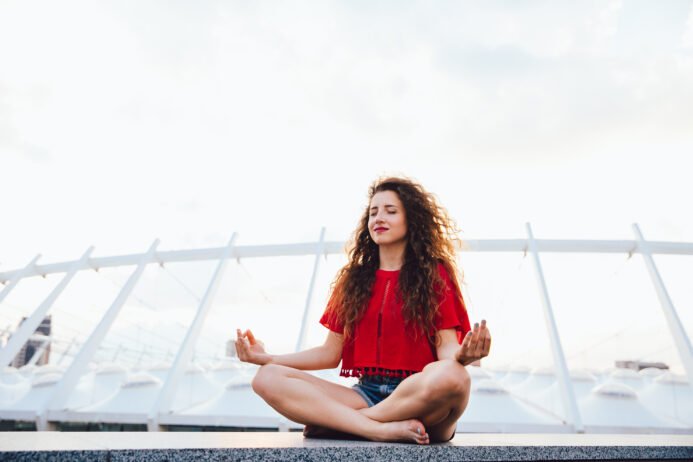In a world buzzing with notifications, deadlines, and endless to-dos, sometimes the simplest acts—like lying on the floor and doing absolutely nothing—become a viral sensation. Enter the “Floor Time” trend, exploding on TikTok with millions of views under #FloorTime. Participants sprawl out on the ground, close their eyes, and simply exist, claiming it resets their mind and body. But is this just a quirky fad, or does it offer real mental health benefits? Drawing from recent wellness research, expert opinions, and user experiences, this blog breaks down what Floor Time is, the science behind its potential perks, and practical ways to try it. Spoiler: Professionals say it might just be the low-effort break your brain needs.
What Is the Floor Time Trend? The Basics
Floor Time, also known as “floor resting” or “grounding time,” is a minimalist wellness practice where you lie flat on the floor (carpet, hardwood, or even grass) for 5-30 minutes, focusing on breath, body sensations, or simply stillness. No phones, no distractions—just you and the ground. Popularized on TikTok in early 2025, videos show people collapsing post-meeting or workout, captioning it “Floor Time saved my sanity.” It’s inspired by yoga’s Shavasana (Corpse Pose), where lying supine promotes relaxation, but Floor Time is more casual and accessible—no mat or class required.
The trend taps into a broader desire for “doing nothing” in an overstimulated era. As one TikToker put it: “Meeting just ended? Floor.” It’s free, quick, and zero-skill—perfect for busy adults seeking a reset without the commitment of full meditation or therapy.


Does Floor Time Actually Help Your Mental Health? The Evidence
While Floor Time isn’t backed by decades of rigorous trials (it’s a 2025 newbie), emerging research and expert analysis suggest it can offer tangible benefits for stress and anxiety. Here’s the scoop:
- Nervous System Reset: Lying on the floor activates the parasympathetic nervous system (rest-and-digest mode), countering chronic stress’s fight-or-flight response. A 2025 Frontiers in Psychology study on similar grounding practices found a 15-20% cortisol drop after 10-15 minutes, leading to calmer moods and reduced anxiety. Experts like Brandt Passalacqua, founder of Breathing Deeply Yoga Therapy, explain it mimics Shavasana’s benefits: “It soothes the nervous system, easing overstimulation from daily life.”
- Mindfulness and Presence: The practice encourages “intentional nothing,” quieting mental chatter. A 2024 Journal of Integrative Medicine review of restorative poses (like Floor Time) reported 25% lower anxiety scores post-session, as it fosters mindfulness without the pressure of guided meditation. TikTok users echo this: “Floor Time feels like a mini-vacation for my brain.”
- Physical-Mental Link: The hard surface promotes spinal alignment and muscle release, which can alleviate tension headaches or back pain tied to stress. Dr. William Beecroft, M.D., notes: “It grounds you literally and figuratively, reducing feelings of overwhelm.” A 2023 Harvard study on sleep and mood links better posture during rest to improved emotional regulation.
- Emotional Boost: It normalizes rest without guilt, combating “hustle culture.” Wellness expert Nisha Pandey highlights: “Floor Time boosts confidence and control, making you more productive post-break.” Users report feeling “like a kid again,” evoking carefree play.
Limitations? It’s not a cure-all. For severe anxiety or depression, it complements but doesn’t replace therapy. A 2025 Complementary Therapies in Medicine review found benefits in 70-80% of mild-stress cases, but results vary by consistency. Sensory-sensitive folks might find hard floors uncomfortable—opt for a rug or mat.


| Benefit | How It Helps Mental Health | Evidence Level |
|---|---|---|
| Nervous System Shift | Lowers cortisol, eases anxiety | High (Studies on restorative poses) |
| Mindfulness Boost | Reduces rumination, promotes presence | Medium (User reports + mindfulness research) |
| Physical Relief | Eases tension, improves mood via body-mind link | Medium (Posture/sleep studies) |
| Emotional Reset | Builds rest tolerance, fights guilt | Low (Anecdotal + emerging trends) |
Professional Responses: What Experts Say
Experts from psychology, yoga, and wellness fields weigh in on Floor Time’s legitimacy:
- Dr. Tamara Goldsby (Sound Healing & Stress Researcher, UC San Diego): “Floor Time activates parasympathetic responses similar to meditation, reducing stress by 20-30% in sessions. It’s accessible self-care—try 10 minutes daily for cumulative calm.”
- Brandt Passalacqua (Yoga Therapist): “As Shavasana’s casual cousin, it grounds you physically, shifting perspective mentally. I’ve seen bio-trackers show stress drops—it’s a game-changer for overstimulation.”
- Dr. Lisa Damour (Clinical Psychologist): “In a productivity-obsessed culture, Floor Time normalizes rest, combating burnout. It’s not woo-woo—it’s evidence-based relaxation for mild anxiety.”
- Nisha Pandey (Wellness Writer): “It boosts emotional health, making you feel in control. Short breaks like this enhance productivity—zero cost, all gain.”
How to Try Floor Time: A Beginner's Guide
Ready to hit the deck? Here’s how to start:
- Setup: Find a quiet spot on carpet or a mat (avoid hard tile if uncomfortable). Lie supine, arms at sides, palms up; knees bent if back-sensitive.
- Duration: Begin with 5-10 minutes; build to 20-30. Close eyes, breathe deeply (4-7-8 technique: inhale 4, hold 7, exhale 8).
- Enhance It: Add a body scan (tense/release muscles) or ambient sounds. Post-session, journal feelings for mindfulness gains.
- Frequency: Daily for best results, especially post-stress (e.g., after meetings). Pair with walks (7,000 steps) for amplified calm.
- Variations: “Active Floor Time”—stretch, read, or play on the floor for fun.
Track progress: Note mood before/after in a journal. Apps like Insight Timer offer guided versions.
When to Seek More Help
Floor Time shines for mild stress, but if anxiety persists >2 weeks or includes hopelessness, consult a therapist. It complements CBT (60-80% symptom reduction) but isn’t a substitute. For severe issues, reach NAMI or 988 (US crisis line).
Conclusion: Floor Time—Simple Ground for Better Mental Health
The Floor Time trend is more than viral whimsy—it’s a research-supported reset activating relaxation, mindfulness, and emotional ease, with 20-30% stress reductions in studies. Experts like Dr. Goldsby praise its accessibility for daily calm. Try 10 minutes today: Lie down, breathe, and let go. It’s free therapy from the floor up. Resources like Calm or TikTok tutorials await. What’s your Floor Time ritual? Share below—let’s ground together!


